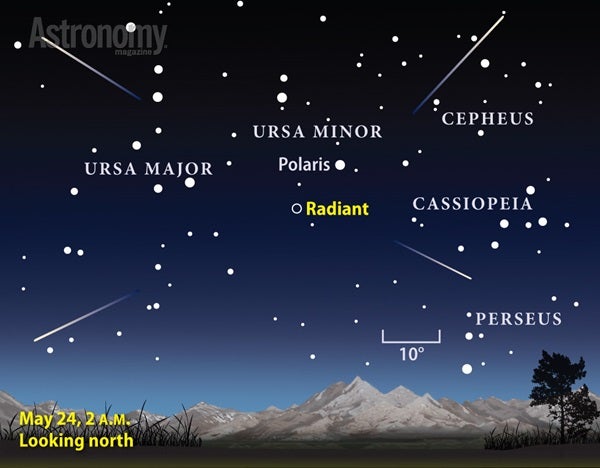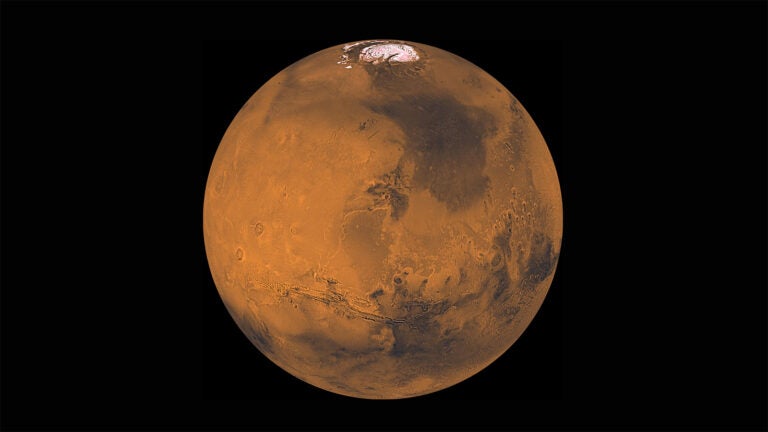Senior Editor Michael E. Bakich of Astronomy magazine loves watching meteor showers and is excited about the possibilities for this one. “Meteor watching has to be one of the easiest, most relaxing forms of entertainment available to backyard skygazers,” he says. “There’s no need for a telescope because optical aid narrows your field of view, and you want to take in as much sky as possible. And best of all, you can observe the spectacle while lying down. Who could ask for more?”
Astronomers expect the shower to peak sometime between 2 a.m. and 4 a.m. EDT the morning of May 24 (11 p.m. to 1 a.m. PDT). This timing works perfectly for observers in the United States and southern Canada. For the best views, find an observing site far from city lights. Light pollution brightens the sky and washes out fainter meteors, lessening the shower’s impact.
The meteors will appear to radiate from a point in the obscure northern constellation of Camelopardalis the Giraffe. (This is why some people have christened the shower with the tongue-twisting name “May Camelopardalids.”) This radiant point lies approximately 10° from the North Star, Polaris, which keeps it on view all night from locations in the Northern Hemisphere. The meteor streaks will appear longer and much more impressive if you look roughly 30° to 45° from the radiant.
These meteors, originally tiny dust particles ejected by Comet 209P/LINEAR, flare to life as they burn up high in Earth’s atmosphere. Astronomers working on the Lincoln Near-Earth Asteroid Research (LINEAR) project discovered 209P/LINEAR on images taken in February 2004. The comet’s orbit around the Sun brings it just inside Earth’s orbit at its closest approach every 5.1 years.
This is the first time that Earth’s orbit has intersected the comet’s orbit at the right position to produce a meteor shower, however. Calculations show that our planet will be encountering dust streams laid down by the comet from the late 18th to early 20th century. Because no one saw the comet in the 1800s, scientists don’t know how much dust it produced back then. So, although astronomers anticipate between 100 and 400 meteors per hour the night of May 23/24, there are no guarantees. The show could be better or worse. Only those who take the time to observe it will know for sure.
Fast facts:
- Although most shower meteors meet their demise in Earth’s atmosphere at altitudes between 50 and 70 miles (85 and 115 kilometers), a few bigger particles survive to within 12 miles (20km) of the surface. These typically produce “fireballs” that glow as bright as or brighter than Venus.
- The meteors from this shower will hit Earth’s atmosphere at 43,400 mph (69,800 km/h). Although this may seem fast, it is slower than the impact velocity associated with any major annual meteor shower.
- Astronomers with the Lincoln Near-Earth Asteroid Research project discovered Comet 209P/LINEAR with a 1-meter telescope located on the White Sand Missile Range in central New Mexico. In 2013, the project started using a 3.5-meter telescope.
- Video: How to observe meteor showers, with Michael E. Bakich, senior editor
- Video: Easy-to-find Objects in the 2014 Spring Sky, with Richard Talcott, senior editor
- StarDome: Locate the shower’s radiant in Camelopardalis in your night sky with our interactive star chart.
- The Sky this Week: Get your meteor shower info from a daily digest of celestial events coming soon to a sky near you.
- Sign up for our free weekly email newsletter.











